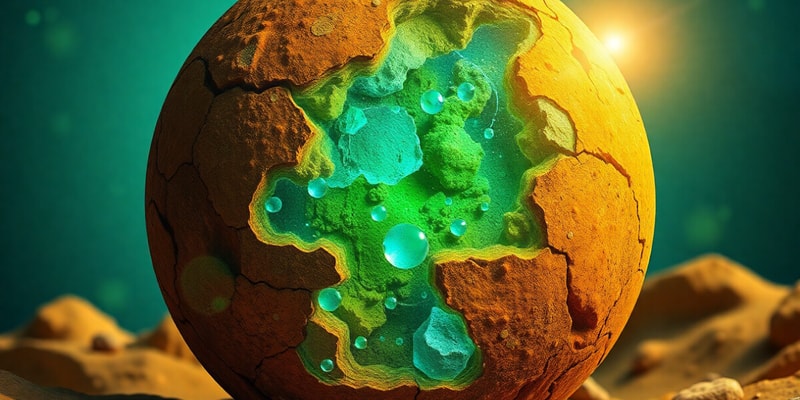Podcast Beta
Questions and Answers
What is the primary objective of biochemistry?
Which elements are commonly described as 'bulk' elements in biological systems?
What is a significant role of metal ions in metabolism?
Which of the following best defines a stereoisomer?
Signup and view all the answers
What characteristic of carbon makes it central to the chemistry of life?
Signup and view all the answers
How do animal and plant cells differ fundamentally?
Signup and view all the answers
What is a feature common to all living organisms?
Signup and view all the answers
The size limit of cells is primarily influenced by what factor?
Signup and view all the answers
What is a characteristic of chiral biomolecule binding?
Signup and view all the answers
What principle does living organisms obey regarding energy?
Signup and view all the answers
What is required for living systems to maintain order?
Signup and view all the answers
How do living organisms maintain a dynamic steady state?
Signup and view all the answers
Which energy molecule is primarily associated with chemical energy storage?
Signup and view all the answers
What is the outcome of catabolic processes in living organisms?
Signup and view all the answers
What does thermodynamics analyze in biological systems?
Signup and view all the answers
What do living systems do to resist the natural tendency toward entropy?
Signup and view all the answers
What is the significance of dynamic transformations in living systems?
Signup and view all the answers
Which statement is incorrect about living organisms as open systems?
Signup and view all the answers
What is a characteristic of enzymatic catalysis?
Signup and view all the answers
Which statement accurately describes biochemical pathways?
Signup and view all the answers
What was a significant outcome of the experiments conducted by Stanley Miller and Harold Urey in 1953?
Signup and view all the answers
What role did RNA likely play in the early stages of life on Earth?
Signup and view all the answers
Which pathway is primarily responsible for transmitting information within a cell?
Signup and view all the answers
What distinguishes diastereomers from enantiomers?
Signup and view all the answers
Which statement is true regarding enantiomers?
Signup and view all the answers
What can be said about the biological effects of stereoisomers?
Signup and view all the answers
What does ΔG represent in the Gibbs free energy equation?
Signup and view all the answers
How is the number of stereoisomers calculated for a molecule with chiral centers?
Signup and view all the answers
Which of the following indicates a spontaneous reaction according to Gibbs' theory?
Signup and view all the answers
Which of the following properties is NOT true for diastereomers?
Signup and view all the answers
Which component of the Gibbs equation is temperature expressed in?
Signup and view all the answers
What implication do macromolecule structures have on molecular interactions?
Signup and view all the answers
What occurs when ΔG equals zero?
Signup and view all the answers
What is the consequence of stereospecificity in molecular interactions?
Signup and view all the answers
Which of the following is true about the solubility of enantiomers versus diastereomers?
Signup and view all the answers
What do endergonic reactions require to proceed?
Signup and view all the answers
Which of the following best describes enantiomers?
Signup and view all the answers
How does energy coupling function in biological systems?
Signup and view all the answers
What happens to the physical and chemical properties of diastereomers compared to their enantiomers?
Signup and view all the answers
What happens to free energy when an exergonic reaction takes place?
Signup and view all the answers
Which of the following best defines enthalpy (ΔH) in this context?
Signup and view all the answers
Which helps drive endergonic reactions in cells?
Signup and view all the answers
If ΔG is positive, what can be inferred about the reaction?
Signup and view all the answers
Study Notes
Earth and Life: A Timescale
- Earth's location in the Solar System provides optimal conditions for life due to its distance from the Sun, leading to suitable thermal energy and radiation levels.
- Earth's revolution around the Sun defines a year, while its self-rotation provides day/night cycles.
- Earth's atmosphere and oceans formed early in its history through complex chemical reactions within its crust.
- The formation of these bodies was influenced by temperature fluctuations and exposure to ionizing radiations.
Formation of Life
- Life originated approximately 4 billion years ago as simple microorganisms capable of energy extraction from chemical compounds.
- These organisms later evolved to utilize solar energy for the synthesis of complex biomolecules.
The Study of Life: Biology and Biochemistry
- Biology studies diverse aspects of living organisms, including their structure, function, growth, origin, evolution, and distribution.
- Chemistry, the study of matter and its transformations, forms the basis of understanding the composition, structure, properties, and reactions of molecules.
- Biochemistry investigates the chemistry of life, focusing on the chemical substances and processes found in living organisms.
Key Features of Living Organisms
- Living organisms exhibit a high degree of chemical complexity and microscopic organization.
- They possess the ability to extract, transform, and utilize energy for maintaining intricate structures and performing essential functions.
- Each component of an organism has a defined function, and their interactions are dynamic and coordinated.
- Living organisms respond to changes in their surroundings.
- They possess the capacity for self-replication and self-assembly.
- Evolution allows living organisms to adapt and change over time.
Cellular Foundations
- All cells share fundamental structural features, regardless of their type or origin.
- The size of a cell is determined by the minimum number of biomolecules required for its functions, with bacterial mycoplasma representing the smallest known cell (300 nm diameter).
- The upper limit of cell size is influenced by the diffusion of solutes in aqueous systems.
- The shape of a cell is influenced by various factors including its type, environment, function, and role in complex systems.
- Differences in structural and functional features between cell types allow for selective control of cell growth and killing using various chemical, biochemical, and biological agents.
- Organisms belong to three distinct domains of life: Bacteria, Archaea, and Eukarya.
- These domains differ significantly in their energy sources and biosynthetic precursors.
- Animal and plant cells, though sharing common building blocks, possess distinct components.
Chemical Foundations
- Carbon, alongside elements like hydrogen, oxygen, nitrogen, phosphorus, and sulfur, are essential for biological systems.
- Some elements like carbon are present in significant quantities (bulk elements), while others, like trace elements, are required in smaller amounts.
- Metal ions (e.g., potassium, sodium, calcium, magnesium, zinc, and iron) play crucial roles in metabolism.
- Carbon's small size, low electronegativity, and ability to form covalent bonds with itself and other elements enable its central role in life's chemistry.
- Carbon hybridization (sp3, sp2, and sp) influences the geometry and shape of molecules.
- Functional groups, like hydroxyl, carbonyl, carboxyl, amino, and phosphate, are common in biomolecules and influence chemical interactions, recognition, and biochemical function.
- The three-dimensional structure of biomolecules is critical for their function and can be represented in different ways.
- Stereoisomers are molecules with the same molecular formula but different three-dimensional arrangement of atoms, leading to distinct physical and chemical properties.
- Enantiomers are chiral stereoisomers that are non-superposable mirror images of each other, while diastereomers are non-superposable stereoisomers that are not mirror images.
- Diastereoisomers are usually found in molecules with more than one chiral center, and these isomers exhibit different physical and chemical properties.
- Stereospecific interactions between molecules are critical for biological function. Only specific molecules can bind to binding pockets in macromolecules due to their stereospecific interactions.
- Different stereoisomers can elicit distinct biological effects. For example, enantiomers of drugs can have dramatically different effects, and different diastereoisomers of the same compound can have different tastes.
Physical Foundations
- Living organisms carry out energy transductions to perform work and maintain their structure and dynamic composition, diverging from their surroundings.
- Molecules are constantly synthesized and broken down. Living organisms are open systems, interacting constantly with their environment.
- Living organisms obey the first law of thermodynamics: the total energy in the Universe remains constant.
- Maintaining order in living systems requires energy and work. This leads to catabolic processes that harvest energy and anabolic processes that use stored energy to synthesize building blocks.
- Living systems maintain a dynamic steady state, keeping the concentrations of key molecules relatively constant, different from their concentrations in the environment.
- Living systems fight against entropy, the tendency toward randomness. This fight requires energy and work.
- Chemical energy is stored in ATP (adenosine triphosphate) and reduced forms of electron carriers like NADH and FADH2.
- Dynamic transformations involving energy generation and consumption maintain the steady state. These transformations can be analyzed using the principles of thermodynamics and kinetics.
- Thermodynamics explores the stability and energy changes in chemical reactions, considering all forms of energy.
- The Gibbs free energy equation (ΔG = ΔH -TΔS) helps quantify energy changes during chemical reactions.
- Thermodynamics focuses on initial and final states, unlike kinetics, which examines the dynamics of the system.
- Reactions with a negative ΔG value are spontaneous and release free energy (exergonic), while reactions with a positive ΔG require energy input and are non-spontaneous (endergonic).
- Energy coupling links reactions in biological systems by combining exergonic and endergonic reactions to achieve an overall free energy change of less than zero. This allows otherwise unfavorable reactions to proceed.
- Endergonic cellular reactions are driven by coupling them to exergonic reactions through shared chemical intermediates.
- Catalysts lower the activation energy of reactions without altering the overall free energy change, speeding up reactions under mild conditions, providing high specificity, and allowing for regulation.
- Biochemical pathways represent series of enzyme-catalyzed reactions that are connected and controlled to regulate metabolite levels.
- These pathways can be either metabolic, producing energy or essential materials, or signal transduction, transmitting information.
Genetic and Evolutionary Foundations
- Life on Earth evolved around 3.5-3.8 billion years ago.
- The ability of cells and organisms to reproduce with high fidelity across generations is a remarkable feature of life. This ability emerged with the development of self-replicating molecules.
- Chemical evolution, the abiotic origin of organic molecules, was demonstrated in 1953 by Stanley Miller and Harold Urey. Their experiment produced amino acids and other simple organic compounds, building blocks for more complex molecules.
- Hydrothermal vents on the ocean floor are considered potential sites for early biogenesis.
- RNA is believed to be the initial information storage molecule in early life due to its dual role as information carrier and biocatalyst. Some viruses still utilize RNA as their primary genetic material.
Studying That Suits You
Use AI to generate personalized quizzes and flashcards to suit your learning preferences.
Related Documents
Description
Test your knowledge on the history of Earth and the origins of life. This quiz covers Earth's formation, its ideal conditions for life, and the evolution of microorganisms. Dive into the fascinating relationship between biology and biochemistry!



